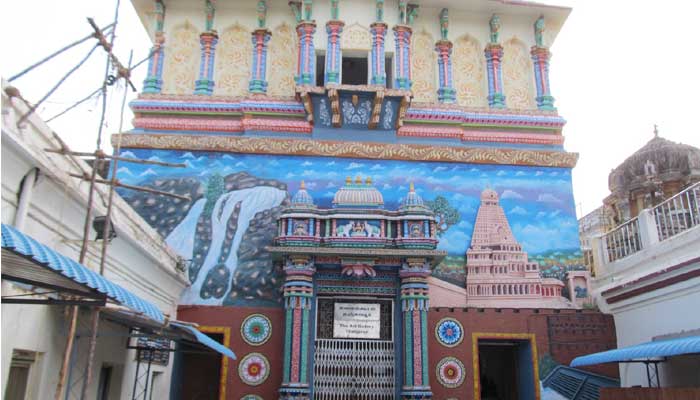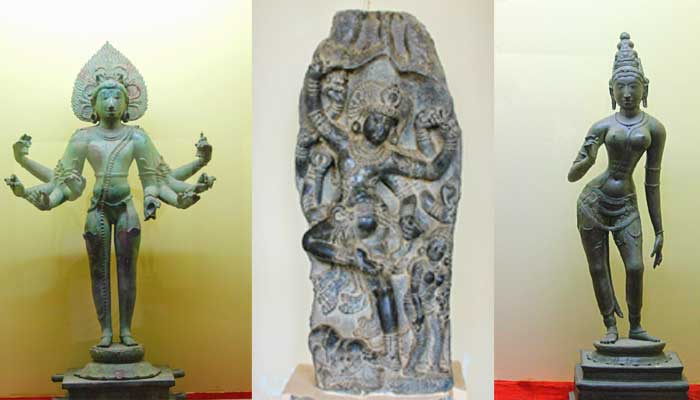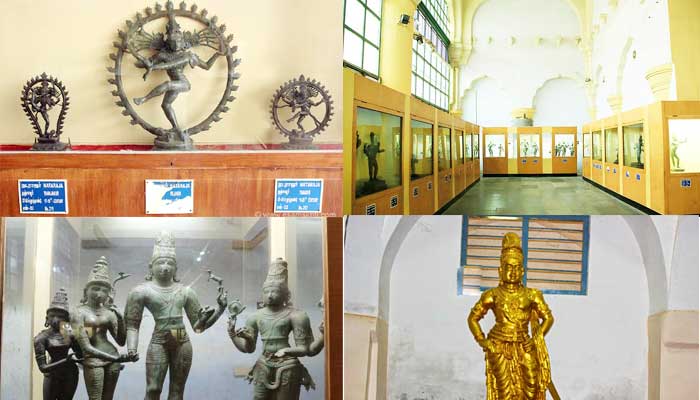
The royal objects that are on display in the museum include royal clothing, headgear and hunting weapons. On the upper floor is a skeleton of a 92-feet whale that washed ashore near Tranquebar in 1955. Thanjavur Palace has the famous Saraswathi Mahal library, an art gallery and the Royal Museum with an interesting collection of artifacts, paintings, books and other memorabilia. The paintings in the Darbar Hall retell the stories from the epic Ramayana. The walls and ceilings are covered with detailed stucco figures of gods and goddesses.

Thanjavur Art Gallery, located in the Thanjavur Palace has an exquisite collection of ancient sculptures and coins. It is officially called the "Raja Raja Chola Art Gallery" and locally known as "Thanjavur Kalaikoodam". These bronze sculptures of Hindu Gods and Goddesses range from 9th century A.D to 19th century A.D. Some very unique deities and saints can be seen. Early Indian lifestyle, their clothing, ornaments and even hairdo are carved in these statues. Another interesting feature is the collection of old coins. Coins from as early as 300 B.C are exhibited here, which is quite astonishing.
Artifacts are placed in a hall which used to be the Kings' royal court (Durbar Hall). The walls and the ceiling of Durbar hall are superbly ornamented with paintings and statuettes. Even the pillars and arches are decorated with fascinating scenes from Hindu epics like Ramayana and Mahabharata. The highlight of the art gallery is of course, the collection of ancient bronze statues.
A lot of stone sculptors and bronze idols that belong to the Chola period, Vijayanagara period and later period are found here. This section is comparatively interesting in the palace complex.

The birth of Thanjavur's Art Gallery was by accident. When an archaeologist from Calcutta spotted a neglected idol by the riverside and wished to take it back to Calcutta Museum, locals demanded that it should stay within the district. The idol was brought and placed in the empty corridor of the palace building. The Collector decreed that all such derelict sculptures should be stored here and thus, the Art Gallery came into existence in 1951.
The high domed hall at the entrance called Pooja Mahal showcases stone sculptures, notably a Muruga idol from Sirkazhi and 12C sculptures from Darasuram Gajasamhara Siva and Bhikshatanar. On the western side of the quadrangle is Rama Chowdham, the private audience hall of the Nayaks. Built in 1600, its massive pillars are capped with stucco figures and a white statue of Maharaja Serfoji with folded arms greets every visitor.
The upper walls are so richly decorated with black and white floral designs, imperial crests, lions and angels; one might miss the real show below glass cases full of exquisite Chola bronzes. Rishabhavahana Devar or Lord Shiva as a peasant with Parvati, Subramanya holding bow and arrow, several Natarajas and Kalyanasundarar, or Lord Shiva's marriage, is outstanding pieces.
Enthol Mukkan Emman :
It is very rare depiction of Lord Shiva as a demon. In this form, he has eight shoulders (enthol) and he has opened his third eye (Mukkan) with two sharp teeth coming out of his mouth. He is shown without any clothes, with 2 serpents around his waist. It is said that this is the only statue ever found with a diabolical representation of Shiva.
Early Tamil Hairdo :
A statue in the art gallery shows the hairdo of a common Tamil man during Raja Raja Chola's time. He has long hair which has beautiful curls at the end. At the top it looks like he is wearing a turban, but it is how he has styled his hair - like a modern day Rastafarian. This hairdo is also shown in paintings of Raja Raja Chola, found in Brihadeeswarar temple.
Brahmadhirayar Statue :
A fascinating bronze statue titled Brahmadhirayar is exhibited, found in 10-11th century A.D. This could be Aniruddha Brahmarayar, a minister of Parantaka Chola II. But more likely, this could also be Krishnan Raman Brahmarayar, the commander-in-chief of Raja Raja Chola and Rajendra Chola. The portrayal shows that he is an obese man, wearing a loin cloth and minimal ornaments. He has a small tuft of hair styled in the front, typical of Brahmin men at that time.
Mudhumakkal Thaazhi :
A fascinating bronze statue titled Brahmadhirayar is exhibited, found in 10-11th century A.D. This could be Aniruddha A 6 feet long burial urn made in 1st century B.C is exhibited here. These earthen vessels called "Mudhumakkal Thaazhi" were used to bury the dead.
Bhikshatana Murti Sculpture :
Another sculpture - the Bhikshatana Murti - is of Shiva in a different mood. Bhikshu means 'mendicant', and in this sculpture Shiva is shown standing wearing little else but wooden sandals, jewellery and a snake wrapped around his waist. Beside him is the pretty form of a dancing deer, which stands on its hind legs to reach up to Shiva's outstretched arm. In the other hand Shiva carries a shallow bowl-like object which is the cause of his predicament.
Brahma, the old god of creation, is said to have lusted after his own daughter. In anger, Shiva struck him, cutting off one of his five heads, and this skull of Brahma's head gets attached to Shiva's palm, like a begging bowl. Shiva becomes a mendicant, going from place to place, like Lady Macbeth trying to get rid of the stain of murder, it is only when he bathes in the Ganga River at Banaras that he is absolved of the 'sin' of murdering a Brahmin and a God.

This is why that spot on the river at Banaras is sacred to the Hindus, who flock there in their thousands to take a dip absolving them of sin, and even to die and be cremated there, to end the cycle of rebirth into lives of sin and misery. In this sculpture, Shiva's face is austere and serious, and his hair is wild and filled with symbols of his power - the crescent moon, the skull, the datura flower and the snake, for he is conqueror of Time and Death.
Sculpture of Vrishabhantika with the Devi :
Another brilliant sculptural piece is the Vrishabhantika with the Devi. Shiva here has one arm raised and bent, as if he were leaning on his bull, Nandi. The Devi, also part of this piece, is an individual sculpture of great beauty and elegance.
Ancient Coins :
There is an excellent collection of old coins, some of them made over 2000 years ago. It is deplorable that they are not being well preserved or arranged in chronological order.
Pudukottai Amman Coins :
Pudukottai Amman Coins are examples of brilliant political and theological propaganda, which saved King Martanda Bhairava Tondaiman's throne. In 1889, King Thondaiman was barely 14 years old and faced a rebellion from his close relatives. Fearing a Coup d'état, his minister Seshayya Sastri came up with an ingenious idea to save the kingdom. According to the plan, Tondaiman announced that the princely state of Pudukottai would be ruled by Goddess Brahadambal.
Tondaiman would only act as her "humble servant" and implement her plans. Furthermore, anybody acting against Goddess Brahadambal's rule would not only be facing charges of rebellion, but also blasphemy. These copper coins were issued in 1889 and distributed all around the state, to spread the message. Needless to say, the trick worked and his enemies were too afraid to overthrow him fearing public backlash.
Mysore Tipu Sultan's copper coins (around 1787 A.D) :
These coins have an elephant figure on one side, and Arabic numerals on the other. Tipu Sultan minted Paisa, Half-Paisa and 1/4 Paisa coins during his regime. Tippu Sultan gold coins, known as Pagodas cannot be found here.
The art gallery is located at King's royal court. In the middle of the royal court (durbar hall) is a statue of King Serfoji II, reminding us of the royal scene that would have existed centuries ago. Serfoji was a brilliant King who spoke 10 languages fluently, built the first zoo in the state of Tamil Nadu, and even performed cataract surgery. Locally referred to as "Sarabhoji Raja", he is credited with implementing educational, administrative and social reforms. He also created an underground drainage system for the city of Thanjavur.
It is rumored that some of the sculptures were stolen here and sold to the Asian Civilizations Museum in Singapore. While visiting the art gallery, make sure you take a look at the stone carvings in the Thanjavur Palace as well. There are only a few tourist attractions in Thanjavur, and the art gallery is definitely one of the top 10 things to do in the city.
A 92 feet skeleton of "Whalebone whale", commonly known as Baleen whale is housed in the Arsenal tower.
The dead whale washed ashore on 26th February 1955 in Tharangampadi beach, and the bones were brought into the palace soon after.
The skeleton is an interesting sight to see, although it has not been well preserved.
A few centuries ago the walls of the palace were covered with rich paintings.
However, most of them have been completely destroyed due to lack of preservation.
Even today, some faded paintings remain and unscrupulous visitors continue to destroy them with graffiti.
The Maratha Durbar Hall has stripes on the octagonal columns and ornate designs on the arches. Portraits of several Maratha rulers including Serfoji can be seen in this hall. The walls are adorned with images of gods and goddesses like Shiva and Vishnu with their consort and Indra and other familiar figures.
The Sangita Mahal, where music and dance flourished under the patronage of the kings, is a miniature of the surviving court of Thirumalai Nayaks. Durbar Hall is the main attraction in Thanjavur Maratha Palace. It was renovated and reconstructed in the current structure by the Maratha King Venkoji in 1684 CE.
There are actually two courtyards, smaller one and the larger one. The smaller one has the wooden roof and an adjoining garden. The larger courtyard has colorful paintings and stucco sculptures from Nayakas and Marathas all over the walls and ceilings.
The paintings make the durbar hall look like a colorful art gallery. The royal throne of the Maratha Kings is also placed in the Durbar Hall. This is the royal court hall, which currently houses the Thanjavur Art Gallery.
Connectivity :
It is located at the heart of the City and located very near to the world famous Brihadeeswarar Temple. Autos and Buses are available to reach this place from Bus Stands & Railway Stations.
Airways :
The nearest airport is Tiruchirappalli airport.
Railways :
Nearest Railway Station is located at Thanjavur.
Roadways :
Royal Palace Museum is 950 Meters (11 Minutes) from Thanjavur old bus stand, 6.9 Kms (17 Minutes) from Thanjavur New bus stand, 58 Kms from Trichy.